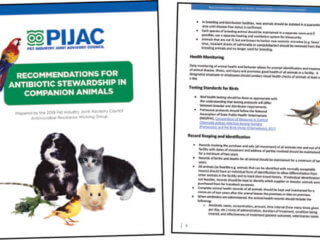Two million people are infected with resistant strains of bacteria and 23,000 deaths result from antibiotic resistance in the U.S. each year, according to Centers for Disease Control and Prevention (CDC) estimates.
What makes this troubling statistic important to the veterinary community, other pet care professionals and pet owners is that two relatively common bacteria species that have resistant strains, Campylobacter and Salmonella, are also common in many pets. While these are not classified by the CDC as urgent threats of greatest concern to human health, they are considered a serious threat.
One example is a 2016 outbreak of antibiotic-resistant campylobacteriosis that involved 113 patients in 17 states, and was determined to be linked to puppies.
Instances like this, along with the fact that resistant strains of bacteria are developing at increasingly rapid rates and outpacing the introduction of new antibiotics, has caused public health officials and the pet care community to actively address the issue of responsible use of antibiotics in companion animals.
“Recognizing that antibiotic resistant germs are a growing and serious health risk to both humans and animals, last year PIJAC committed to work with the pet care community to create best management practices to combat AMR as part of our participation in the Antimicrobial Resistance (AMR) Challenge,” says Savonne Caughey, director of government affairs for the Pet Industry Joint Advisory Council (PIJAC).
The AMR Challenge is a yearlong U.S. government effort to accelerate the fight against antimicrobial resistance with action across governments and industries that launched in September 2018.
As of mid–December 2018, nearly 150 organizations have joined and made over 140 commitments to the Challenge. Veterinary and other companion animal–related organizations and companies that have joined include the American Animal Hospital Association (AAHA), American Association of Avian Pathologists, American Veterinary Medical Association (AVMA), Animal Health Institute, Boehringer Ingelheim, Elanco, Merck, Petco and Zoetis.
In March at the Global Pet Expo trade show in Orlando, PIJAC unveiled an industry–wide, comprehensive set of recommendations for antibiotic stewardship and combatting antimicrobial resistance (AMR) in companion animals, Recommendations for Antibiotic Stewardship in the Pet Care Community.
Encompassing a unified set of principles for all sectors of the pet care community, the recommendations have an emphasis on those involved in the breeding, rearing, transport and sale of companion animals as well as those who work with products where antibiotics regularly intersect with animals.
Mike Bober, president and CEO of PIJAC, says, “Having served as the pet industry’s liaison on public health issues and zoonotic disease prevention for over a decade through our memorandum of understanding with the CDC, we were in the ideal position to spearhead development of this resource that will encourage responsible stewardship and reduce practices that contribute to antimicrobial resistance in an effort to protect public and animal health.”
PIJAC piloted the guide’s development through an extensive process of gathering resources, conducting research and consulting with specialists, professionals and others in a variety of pet care roles. The final recommendations were developed by a working group comprised of stakeholders and experts including pet care retailers, manufacturers, breeders, distributors, authorities in animal care, and representatives from the veterinary medicine and health communities and other trade associations.
“PIJAC and the working group consulted with animal health experts as well as breeders and animal handlers regarding their stewardship practices, disease prevention strategies, vaccination protocols, hygiene practices and routine health monitoring,” Bober says.
Input was also collected from leading voices across the pet care community, both directly and during town–hall meetings at Global Pet Expo and SuperZoo, the two largest pet industry gatherings in the country.
Resources that were used to develop the document include published recommendations, guidelines and best management practices for animal care and disease management from leading organizations including AAHA, AVMA, the American Association of Feline Practitioners, CDC, National Association of State Public Health Veterinarians, and the U.S. Food and Drug Administration.
Tom Edling, DVM, MSpVM, MPH, former vice president of veterinary medicine for PETCO and a member of the working group says, “We paid particular attention to the fact that this issue can only be successfully addressed through comprehensive efforts that encompass sanitation, transportation, and preventative care in addition to veterinary oversight of antibiotic use.”
Disease prevention, management and remediation across every step in the companion animal care process were evaluated in order to cover best management practices on topics such as use of antibiotics, veterinary oversight, sanitation, hygiene and zoonotic disease prevention, among others.
“The veterinarian community is a critical component of any disease management effort’s success,” says working group member Dave Dzanis, DVM, PhD, DACVN, a veterinary consultant to the American Pet Products Association. “Animal health companies and manufacturers of antibiotics should encourage policies that promote judicious use of antibiotics, while increasing veterinarian oversight, and continuing to develop new tools to address animal diseases.”

Laura “Peach” Reid, president of Fish Mart, Inc., in West Haven, Conn., and chair of the board of directors of PIJAC says, “With widespread adoption of the recommendations by the pet care community, we will help inhibit the development of resistant germs and ensure healthier pets and healthier people around the world.” +


